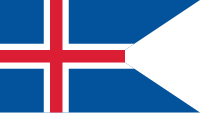Icelandic Coast Guard
| Icelandic Coast Guard Landhelgisgæsla Íslands |
|
|---|---|
 |
|
| Active | 1920 |
| Country |
|
| Role | National Defence, Law enforcement, Maritime and Aviation Search and Rescue, Counter Terrorism, Minesweeping, Explosive Ordnance Disposal, Hydrographic Service and other tasks. |
| Size | 3 x Patrol vessels 1 x Fixed wing aircraft 3 x Helicopters 2 x Patrol/survey boat 200 x Officers and men |
| Nickname(s) | Gæslan (The Guard) |
| Motto(s) | "Við erum til taks" ("Always Prepared") |
| Engagements |
World War II Cod Wars Iraq War |
| Commanders | |
| General Director | R.Adm Georg Kr. Lárusson |
| Chief of Operations | Capt. Ásgrímur L. Ásgrímsson |
| Chief of Aeronautical Division | Cdr. s.g. Sindri Steingrímsson |
| Insignia | |
| Naval Ensign |  |
| Racing stripe |  |
| Aircraft flown | |
| Patrol | 1 Bombardier DHC-8-Q314 |
| Transport | 3 Aérospatiale AS-332L1 Super Puma |
The Icelandic Coast Guard (Icelandic: Landhelgisgæsla Íslands, Landhelgisgæslan or simply Gæslan) is the service responsible for Iceland's coastal defense and maritime and aeronautical search and rescue. Its origins can be traced to 1859, when the corvette Ørnen started patrolling Icelandic waters. In 1906, Iceland's first purposely built guard-ship, Islands Falk, began operation. Iceland's own defense of its territorial waters began around 1920 and the Icelandic Coast Guard was formally founded on July 1, 1926. The first cannon was put on the trawler Thor in 1924 and on June 23, 1926 the first ship built for the Coast Guard, named Óðinn, arrived in Iceland. Three years later, on the 14 July 1929 the coastal defence ship Ægir was added to the Coast Guard fleet.
The Icelandic Coast Guard played its largest role during the Cod Wars between 1972 and 1975, when the Coast Guard ships would cut the trawl wires of British and West German trawlers and engaged in confrontations with Royal Navy warships, in order to enforce a disputed expansion on Icelandic fishing territory.
The Coast Guard also maintains the Iceland Air Defence System which conducts ground surveillance of Iceland's air space.
The Icelandic Coast Guard's (ICG) primary mission is the defending the Icelandic sovereignty, integrity of the territorial waters, maintaining Icelandic law and order inside the 200 nm wide Economic zone as well as other vital missions such as Search and Rescue. The Coast Guard operates JRCC-Iceland which is responsible for search and rescue of vessels and aircraft in Iceland's search and rescue region (SRR) according to International Aeronautical and Maritime Search and Rescue (IAMSAR) Manual. Additionally the ICG is in the charge of defusing naval mines, most of which were laid during the Second World War, and monitoring fisheries in International waters outside of the Icelandic Economic zone in order to blacklist any vessel partaking in unregulated fishing and thus bar them from receiving services from any member of the North East Atlantic Fisheries Commission in order to make unregulated fishing unprofitable. The Icelandic Coast Guard also occasionally operates within Greenlandic and Faeroese waters, following a bilateral agreement with Denmark regarding mutual aid in security, rescue and defence matters.
...
Wikipedia
